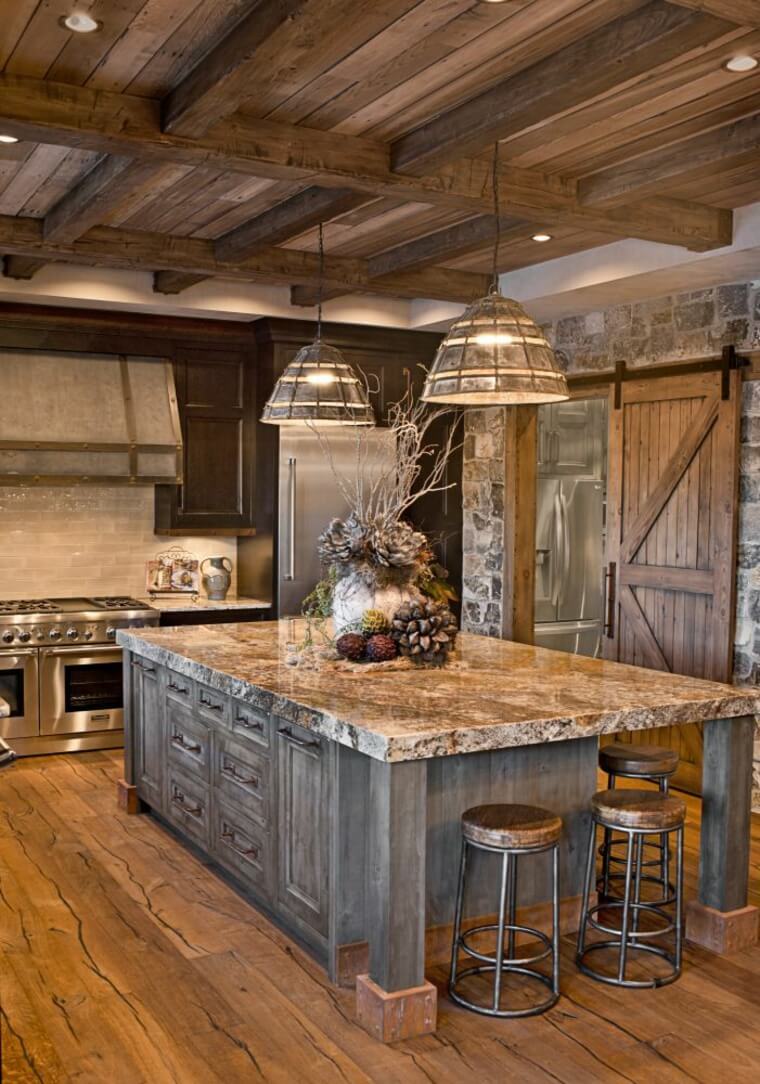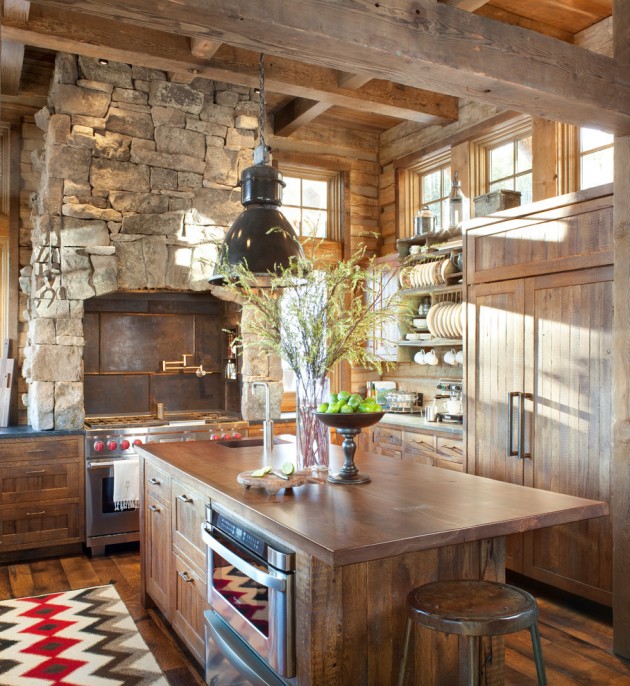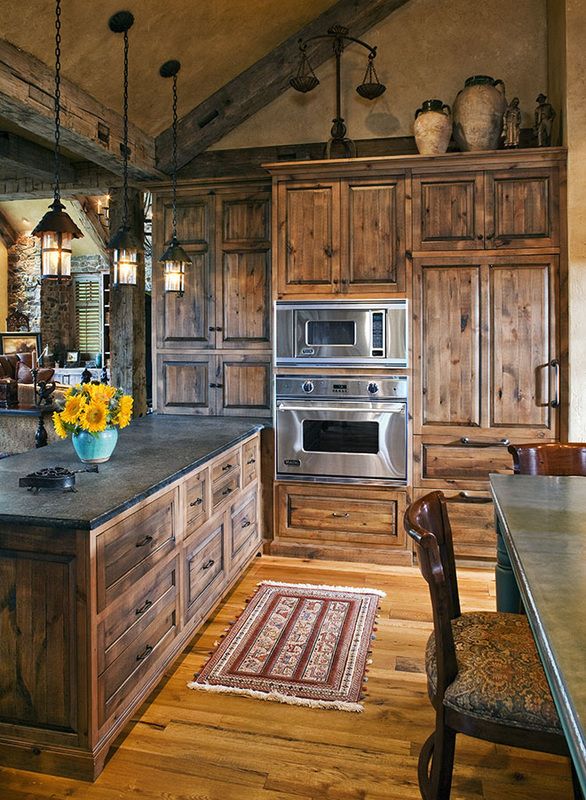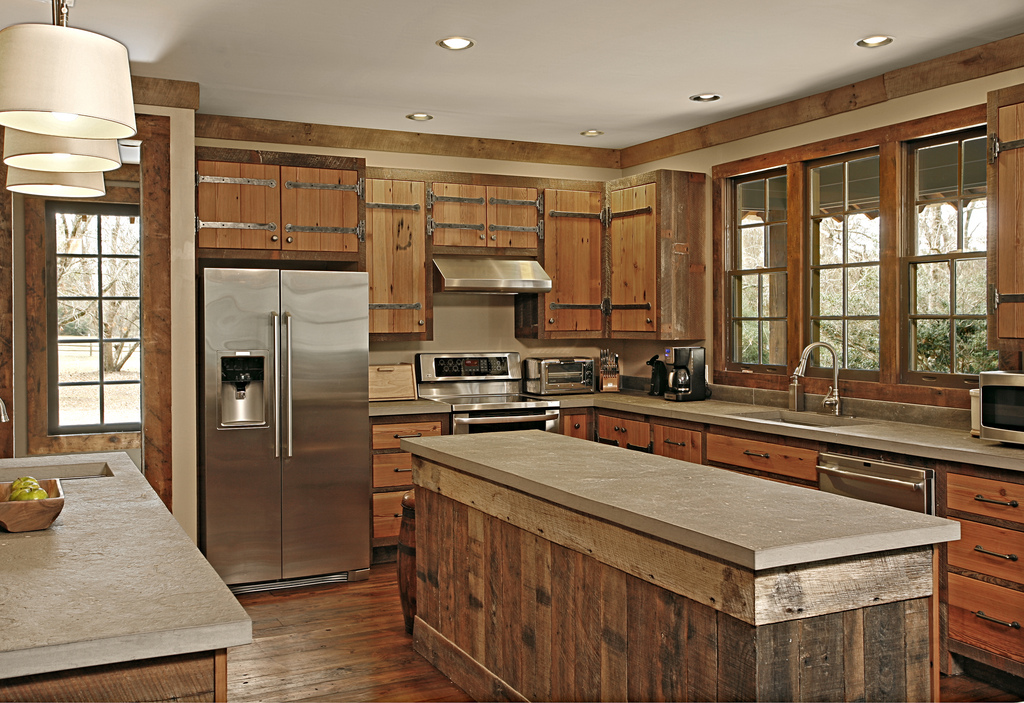When envisioning a cozy, rustic retreat, one of the most essential elements that comes to mind is the kitchen. Cabin-style kitchen cabinets play a crucial role in creating that warm, welcoming atmosphere synonymous with a mountain lodge or a lakeside retreat. These cabinets are not just functional storage solutions; they embody the essence of rustic living, blending natural materials, earthy tones, and handcrafted details to evoke a sense of simplicity and connection with the outdoors.
Cabin-style kitchen cabinets often feature natural wood finishes that highlight the wood’s grain and texture. Woods like pine, cedar, hickory, and oak are popular choices because they bring warmth and a natural aesthetic to the space. The beauty of these woods lies in their imperfections—knots, varying grain patterns, and even minor blemishes add character and authenticity to the design. For those who desire a more rustic look, distressed finishes can be applied to the cabinets, creating a time-worn appearance that enhances the cabin vibe.

Another hallmark of cabin-style kitchen cabinets is their simple, sturdy design. These cabinets often eschew intricate detailing in favor of clean lines and functional forms. The focus is on durability and practicality, reflecting the hardworking, no-nonsense nature of traditional cabin life. However, this simplicity doesn’t mean the cabinets lack charm. Small details, such as wrought iron or antique brass hardware, can add a touch of old-world craftsmanship, further contributing to the rustic feel.
Incorporating cabin-style kitchen cabinets into a modern home requires careful consideration of the overall design scheme. The cabinets should complement other elements in the kitchen, such as countertops, backsplashes, and flooring. Natural stone or butcher block countertops pair beautifully with these cabinets, adding to the earthy, organic aesthetic. Backsplashes made from materials like stone, brick, or even metal can enhance the rustic charm, while wide plank wood or stone tile floors complete the look.

Color choices for cabin-style kitchen cabinets are typically on the warmer side of the spectrum, with shades of brown, beige, and even deep green or blue being popular options. These colors help to create a cozy and inviting atmosphere, perfect for a cabin setting. However, lighter hues like cream or pale grey can also work well, particularly in smaller spaces where you want to keep the area feeling open and airy. The key is to choose colors that harmonize with the natural elements of wood and stone, creating a cohesive and balanced look.
Customization is another vital aspect of cabin-style kitchen cabinets. Because each cabin is unique, the cabinets should be tailored to fit the specific needs and style of the space. This could mean adding extra storage solutions like open shelving, glass-fronted doors, or pull-out drawers to maximize functionality without sacrificing aesthetics. Customization also allows for the incorporation of personal touches, such as hand-carved details or unique hardware, that reflect the owner’s personality and enhance the cabin’s character.

Lighting plays a crucial role in showcasing cabin-style kitchen cabinets. Since these cabinets are often made from natural materials, proper lighting can accentuate their beauty and craftsmanship. Under-cabinet lighting is particularly effective, highlighting the texture of the wood and the details of the design. Pendant lights with a rustic or industrial flair can also enhance the cabin aesthetic, providing both functional illumination and decorative appeal.
The appeal of cabin-style kitchen cabinets extends beyond their rustic charm. These cabinets also offer a sense of timelessness and durability, making them a wise investment for homeowners who value quality and longevity. Unlike trendy designs that may fall out of fashion, cabin-style cabinets are rooted in tradition and craftsmanship, ensuring they remain relevant and appealing for years to come. Additionally, their versatility means they can be adapted to suit a variety of interior styles, from traditional log cabins to contemporary mountain homes.
One of the challenges of cabin-style kitchen cabinets is ensuring they don’t overwhelm the space, particularly in smaller kitchens. It’s important to strike a balance between the rustic elements and modern conveniences. For example, pairing cabin-style cabinets with sleek, modern appliances can create a harmonious blend of old and new. Similarly, incorporating minimalist design elements, such as simple lighting fixtures and uncluttered countertops, can prevent the space from feeling too heavy or dated.

Sustainability is an increasingly important consideration in kitchen design, and cabin-style cabinets can align with eco-friendly principles. Choosing cabinets made from reclaimed wood or sustainably sourced materials can reduce the environmental impact of your kitchen renovation. Additionally, opting for non-toxic finishes and low-VOC paints can contribute to a healthier indoor environment. These choices not only benefit the planet but also add another layer of authenticity to the cabin aesthetic, emphasizing a connection with nature and a commitment to preserving it.
Maintenance is another aspect to consider when choosing cabin-style kitchen cabinets. While these cabinets are generally durable, they require regular care to maintain their appearance and longevity. Wood cabinets, in particular, need to be protected from excessive moisture and temperature fluctuations, which can cause warping or cracking over time. Regular cleaning with gentle, non-abrasive products is also essential to preserve the wood’s natural beauty. By taking these precautions, you can ensure your cabin-style cabinets remain a focal point of your kitchen for years to come.
The versatility of cabin-style kitchen cabinets means they can be adapted to various design themes. Whether your style leans more towards the traditional rustic, modern farmhouse, or even industrial chic, these cabinets can be customized to fit your vision. For a more traditional look, pair them with natural stone countertops, exposed beams, and vintage-style appliances. If you prefer a modern twist, consider incorporating sleek hardware, minimalist lighting, and contemporary fixtures to create a balanced, eclectic aesthetic.

In terms of layout, cabin-style kitchen cabinets work well in both open-plan and more traditional kitchen configurations. In an open-plan setting, the cabinets can help define the kitchen area, creating a cozy, intimate space within a larger room. In a more traditional layout, the cabinets can be used to maximize storage and functionality, with options like corner cabinets, pantry units, and pull-out shelves adding to the practicality of the space.
When selecting cabin-style kitchen cabinets, it’s essential to consider the overall ambiance you want to create. Do you want a dark, moody atmosphere reminiscent of a secluded mountain lodge, or a bright, airy space that feels like a lakeside retreat? Your choice of wood species, finish, and color will all play a role in achieving the desired effect. Additionally, the choice of hardware, lighting, and accessories will further enhance the mood and style of the kitchen.
Last, cabin-style kitchen cabinets offer a unique opportunity to express your style and creativity. Whether you choose to go all-in on the rustic theme or prefer to mix and match elements from different styles, these cabinets provide a versatile canvas for your design ideas. By carefully selecting materials, colors, and finishes, you can create a kitchen that reflects your personality, meets your functional needs, and enhances the overall aesthetic of your home.

Common Mistakes to Avoid
When designing a kitchen with cabin-style cabinets, one of the most common mistakes is choosing the wrong wood species or finish. It’s essential to select materials that complement the overall design of your home and meet your practical needs. For instance, while pine is a popular choice for its rustic charm, it’s also a softer wood that may dent or scratch more easily than harder woods like oak or hickory. Similarly, opting for a finish that’s too dark or too light can throw off the balance of the space. Striking the right tone is crucial for achieving a cohesive look.
Another common mistake is overcrowding the kitchen with too many rustic elements. While the cabin style is all about embracing natural materials and a handcrafted aesthetic, it’s important to avoid going overboard. Too much wood, stone, or wrought iron can make the space feel heavy and overwhelming. Instead, aim for a balanced mix of rustic and modern elements to keep the kitchen feeling fresh and inviting. For example, pairing rustic cabinets with sleek, stainless steel appliances or minimalist lighting can create a more dynamic and contemporary look.
Neglecting functionality in favor of aesthetics is another pitfall to avoid. While it’s easy to get caught up in the visual appeal of cabin-style cabinets, it’s important to ensure that they meet your storage and organizational needs. Consider factors like cabinet height, depth, and accessibility when designing your kitchen layout. Adding practical features like pull-out shelves, lazy Susans, or deep drawers can enhance the functionality of the space without detracting from its rustic charm.
Improper lighting is another mistake that can detract from the beauty of cabin-style kitchen cabinets. These cabinets often feature rich, natural wood tones that can darken a room if not properly illuminated. Incorporating a mix of ambient, task, and accent lighting is essential for highlighting the cabinets and creating a warm, welcoming atmosphere. Under-cabinet lighting, in particular, can showcase the wood’s texture and grain, adding depth and dimension to the space.
Finally, failing to maintain your cabin-style kitchen cabinets properly can lead to premature wear and tear. Wood cabinets, in particular, require regular care to prevent damage from moisture, heat, and everyday use. Be sure to clean your cabinets regularly with a soft, damp cloth and avoid harsh chemicals that can strip the wood of its natural oils. Additionally, consider applying a protective finish or wax to keep the wood looking its best for years to come.

What wood types are best for cabin-style kitchen cabinets?
The best wood types for cabin-style kitchen cabinets are those that offer durability, natural beauty, and a rustic feel. Popular choices include pine, cedar, hickory, and oak. Pine is known for its warm, golden tones and rustic knots, while cedar offers a rich, reddish hue with a distinctive grain pattern. Hickory is a harder wood with striking color variations, and oak provides a classic look with its strong, pronounced grain. Each wood type has its unique characteristics, so the best choice depends on your aesthetic preferences and functional needs.
How can I incorporate cabin-style cabinets into a modern kitchen?
To incorporate cabin-style cabinets into a modern kitchen, focus on balancing rustic and contemporary elements. Pair the natural wood cabinets with modern materials like stainless steel, glass, or quartz for countertops and backsplashes. Choose minimalist hardware with clean lines, such as brushed nickel or matte black finishes, to maintain a sleek look. Lighting is also key—opt for modern fixtures like pendant lights or LED under-cabinet lighting to highlight the cabinets while keeping the overall design fresh and contemporary. The goal is to blend the warmth and charm of cabin style with the simplicity and functionality of modern design.
What finishes work well with cabin-style kitchen cabinets?
Finishes that work well with cabin-style kitchen cabinets typically enhance the natural beauty of the wood. Clear or lightly tinted stains are popular because they allow the wood’s grain and texture to shine through. For a more rustic look, consider a distressed or weathered finish, which adds character and a time-worn appearance. Matte or satin finishes are often preferred over high-gloss options, as they contribute to the earthy, understated aesthetic typical of cabin style. The right finish should complement the wood type and color while enhancing the overall cabin-inspired ambiance of the kitchen.

How do I maintain and clean cabin-style kitchen cabinets?
Maintaining and cleaning cabin-style kitchen cabinets involves regular care to preserve their natural beauty and durability. Dust the cabinets regularly with a soft, dry cloth to prevent the buildup of dirt and debris. For more thorough cleaning, use a mild soap and water solution, but avoid soaking the wood. It’s crucial to dry the cabinets immediately after cleaning to prevent water damage. Avoid using harsh chemicals or abrasive cleaners, as they can damage the wood’s finish. Periodically, apply a protective wax or oil to nourish the wood and keep it looking its best. Proper care will ensure your cabinets remain a beautiful focal point in your kitchen for years to come.
Can cabin-style kitchen cabinets be customized?
Yes, cabin-style kitchen cabinets can be highly customized to fit your specific design preferences and functional needs. Customization options include choosing the type of wood, finish, hardware, and cabinet configuration. You can also add unique features like open shelving, glass-fronted doors, or carved details to enhance the rustic charm. Custom cabinets allow you to create a kitchen that reflects your style and meets your storage and organizational requirements. Whether you want to incorporate specific design elements or need cabinets tailored to a unique space, customization offers endless possibilities.
What are the cost considerations for installing cabin-style kitchen cabinets?
The cost of installing cabin-style kitchen cabinets can vary widely depending on several factors, including the type of wood, level of customization, and installation complexity. Generally, solid wood cabinets tend to be more expensive than those made from engineered wood or laminate. Custom cabinets will also increase the cost compared to stock or semi-custom options. Additionally, the choice of hardware, finishes, and any additional features like pull-out shelves or specialty drawers can impact the overall price. It’s essential to establish a budget and work with a designer or contractor to select options that align with your financial plan while achieving your desired cabin-inspired look.

Related Posts:
- Refurbish Kitchen Cabinets Do It Yourself
- Interior Design Ideas For Kitchen Cabinets
- Kitchen Cabinets Wisconsin
- Kitchen Cabinets In Bedroom
- Kitchen Cabinet Recipes
- 12 Deep Kitchen Cabinets
- Wood Veneer Sheets For Kitchen Cabinets
- Cherry And White Kitchen Cabinets
- Kitchen Cabinet Accessories Prices
- 405 Kitchen Cabinets